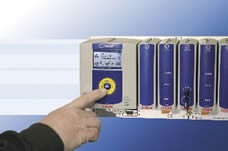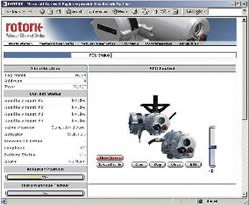An Introduction to Networks Control systems for valve actuators

The new Rotork Pakscan P3 masterstation

Screen showing an actuator’s current status over an Ethernet link from a Pakscan
Zhenhai oil tank farm at the port of Ningbo, eastern China. More than 200 Rotork IQ actuators, most with Pakscan 2-wire digital control are installed on this 33m barrel capacity site.
Traditional valve actuator control systems use individual cables for each signal to be transmitted from the field to the control room. As actuators in the plant have become more important as a source of operating information, this has led to more and more cables being required for the collection of the actuator data. Today this can result in more than twenty individual terminations being required at each actuator. The proliferation of cables, cable trays and interface racks etc. etc. has increased in proportion to the size of the plant, resulting in greatly increased material and installation costs.
The impact of digital technology
Using digital network technology, large numbers of parallel wires can be replaced by a single two, three or four core cable interconnecting scores of individually addressable actuators and carrying the same amount - if not more - information between the plant and control room.
Installation costs are dramatically reduced, plant efficiency is enhanced and reliability is improved. In addition, digital communication can fully exploit the data gathering potential of an ‘intelligent’ valve actuator to facilitate improved diagnostics and predictive maintenance.
Digital network systems also allow for rapid plant upgrades and simplify the work involved in altering plant functionality, enabling the operator to more readily adapt the plant to changing market requirements. Engineering work is greatly simplified and commissioning times reduced. Finally, despite a potentially higher initial cost for some of the hardware elements, the final cost of ownership will come down.
Proprietary and open systems
There are two fundamentally different types of network systems available. Open systems are designed to be used with various different items of plant equipment whilst proprietary (or closed) systems are designed to suit the specific requirements of one type of equipment or equipment from a single manufacturer.
In the 1980’s Rotork was one of the first manufacturers to introduce a digital network capability to the world of actuators and valve control. Known as Pakscan, the Rotork system uses a proprietary protocol for network communication. The advantage of a proprietary system is that the network can be optimised to exactly match the needs of the elements connected to it. For example, Pakscan can cope with extremely long data highways of up to 20km without the need for repeaters, it is able to cope with the removal of power from any actuators on the network at any time and also protects against cable failures by providing dual communication paths at all times (communication in both directions along the highway loop). There are no open systems that can do this unless they are extensively modified from their original design and almost all cable systems other than Pakscan will be compromised by the need to cover such long distances.
The last twenty years have also witnessed the development of many open systems including Modbus, Profibus, DeviceNet and Foundation Fieldbus. These various standards have been passed into the public domain, documented and controlled by the IEC and other authorities in the USA and Europe as well as other parts of the world.
The advantage promoted by open systems is the ability to mix and match equipment from several different manufacturers on the same highway. Thus a Profibus network can support actuators, flow sensors, pumps and motor drives on the same bus highway. This is advantageous where there are only a few devices of each different type and it would be uneconomic to use independent, proprietary buses for each manufacturer.
Choosing between proprietary and open
Making the choice between a proprietary and open system is an important decision when selecting the network for valve actuators. Unlike virtually every other item of plant equipment, the valve actuator is generally inactive for over 90% of the time. However, when required to operate it is usually for an important reason. Therefore, knowing that the valve and actuator are available for the task and that it is successfully completed are essential requirements.
Any of the open systems are capable of reporting the actuator status and carrying the command to move the valve. The choice between them depends on factors such as distance from the control room, number of devices required on the network, the availability of compatible
So why should a proprietary system be considered? Well, it is often the case that the valve actuator network only carries actuators from one supplier and if that is the case with Rotork then using Pakscan offers many advantages, since it has been specifically designed for actuator control and is tailored for use on sites where they are found. Pakscan can achieve much longer highway lengths than any open system and offer impressive data refresh times despite using apparently slow communication rates.
In addition it offers increased safety by including a high degree of fault protection and facilitates the practice of isolating individual valves by powering down the actuators without affecting the communication highway at all. Such inherent features coupled with developments now including Ethernet compatibility usually make Pakscan the network of choice for Rotork actuators.equipment for other tasks, the integrity of the control required and so on. So, the advantage of an open system to allow multiple devices from several manufacturers to share the network may make it the preferred choice. However, there is a penalty for this choice. All open systems have a relatively high data overhead to allow for message transactions, configuration and other network maintenance functions. This overhead has the effect of slowing the data refresh time so that they must run at high communication data rates to restore a suitable refresh time.

| Telephone: | 0113 256 7922 |
| Email: | mail@rotork.com |
| Website: | www.rotork.com |
| More information on the Rotork UK BVAA Member Directory Page |
Search related valve / actuator articles: Rotork UKIssue 1Electric Actuators







-web.jpg)





